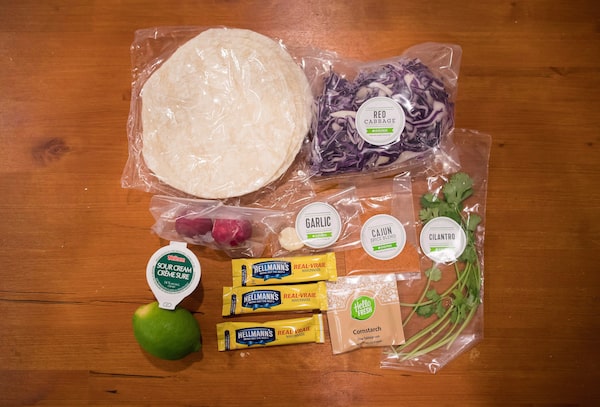
Meal kits, like the Hello Fresh cajun fish tacos pictured above, are becoming increasingly numerous.DARRYL DYCK/The Canadian Press
When nutritionist Lonie Murdock started prepared meal service Eat Train Live in 2015, she had few competitors in the Toronto market.
But in the last few years, she’s noticed new prepared meal or meal kit services springing up constantly.
Each has different dishes and policies, creating a minefield of considerations and possible confusion for consumers just looking for an easy – and tasty – meal.
To figure out what kind of service or kit is best for you, Murdock recommends thinking about how often you intend to eat, what size portions you prefer and what kinds of food you most enjoy.
Once you answer those questions, you can use the information to find a service that fits your dietary needs, can offer any meal you desire and won’t provide portions that leave you hungry or with plenty of leftovers.
When researching options, she says to look for services with flexibility – meatless options, shorter preparation and bake times for busy nights and dishes that match multiple moods and occasions.
Murdock says a lot of people want to try out one meal before they subscribe for a longer period of time, but she recommends trying at least a few days of a service.
“What if you get that one meal and you hate it, but there are 12 others options to choose from and you end up loving the other 11,” she said. “You won’t know that unless you try more than a meal.”
She suggests first-timers look for or ask about trial periods and starter discounts they can use to explore if a service is right for them.
Services don’t just offer meals, many can also provide snack and dessert options. But that doesn’t mean you should purchase a plan that covers every meal.
It might not be worth it to opt in for breakfast, if you have a routine of blending up a smoothie every morning or if you skip the meal altogether, Murdock says.
“I always tell people to focus on what you do best at home,” she says. “But if you’re a person who has got three kids to get out the door and maybe breakfast is not something you do well, consider (a service).”
Many services offer their best prices at the beginning of the year or summer, when people have just made New Year’s resolutions to eat healthier or when they’re trying to get fit for swimsuit season, Murdock says.
Consumers, she says, should also be conscious of deadlines. Many subscriptions require you to order by a specific date, so they can prepare ingredients in time. If you don’t order in time, expect hefty additional fees or to go without service for that order period.
The average service can cost anywhere from a few dollars to $12 per portion and the bill will quickly add up if you’re purchasing many meals for long stretches of time.
To keep the cost down, consider locking in for a longer subscription or more portions.
“If you want the incentives or to order more for less, find another person to share with,” Murdock suggests.
While dinner is often the meal most people want a service for, Murdock says it also tends to be the most expensive. Customers, she says, should beware that items including shrimp, steak and salmon often come with premium prices too.
If you are being cost conscious, keep an eye out for discount codes that many services hand out at transit stations and busy streets or offer for customers who refer friends.
Remember to take a careful look at the fine print when you subscribe to a service, says Murdock. Many services will auto renew and charge your credit card if you don’t cancel by specific dates.